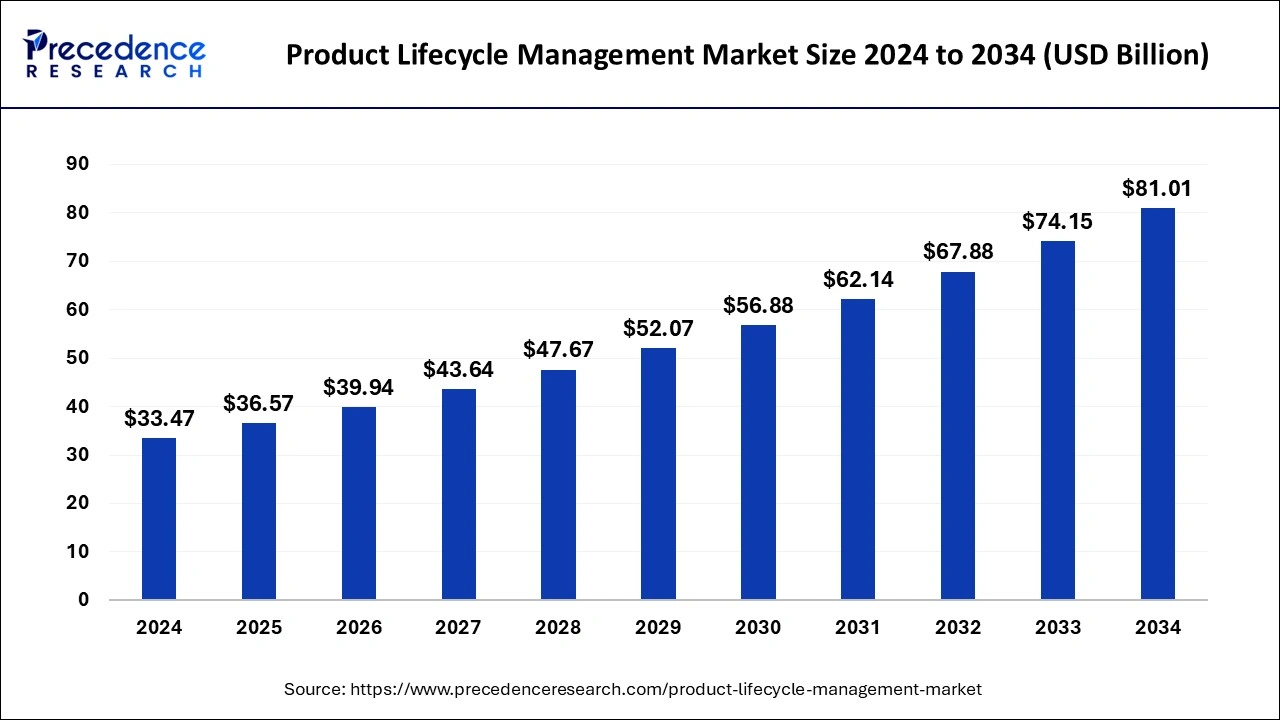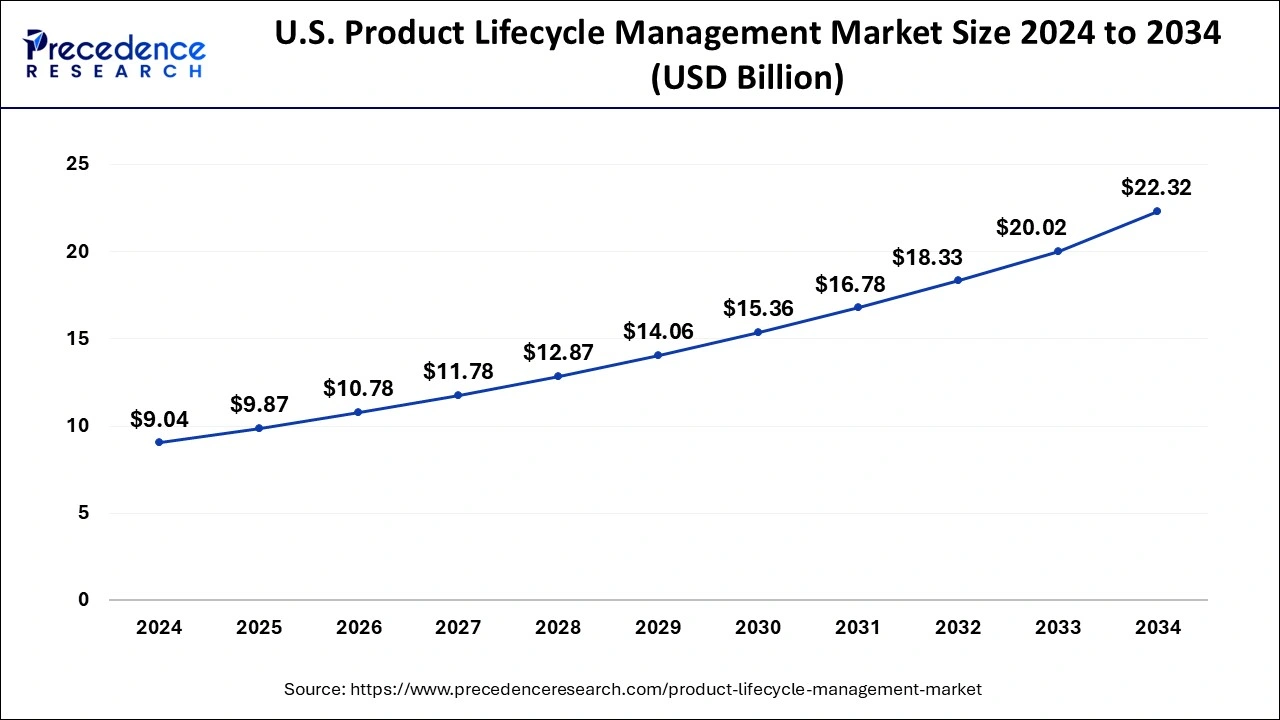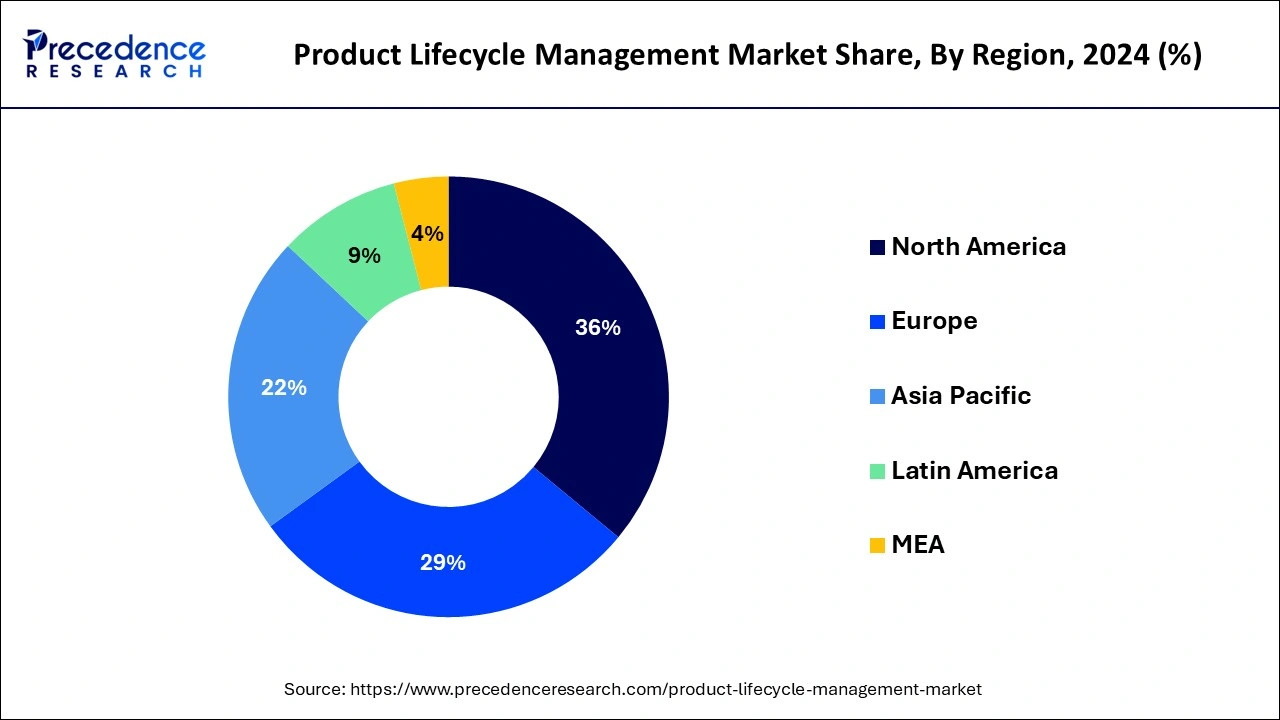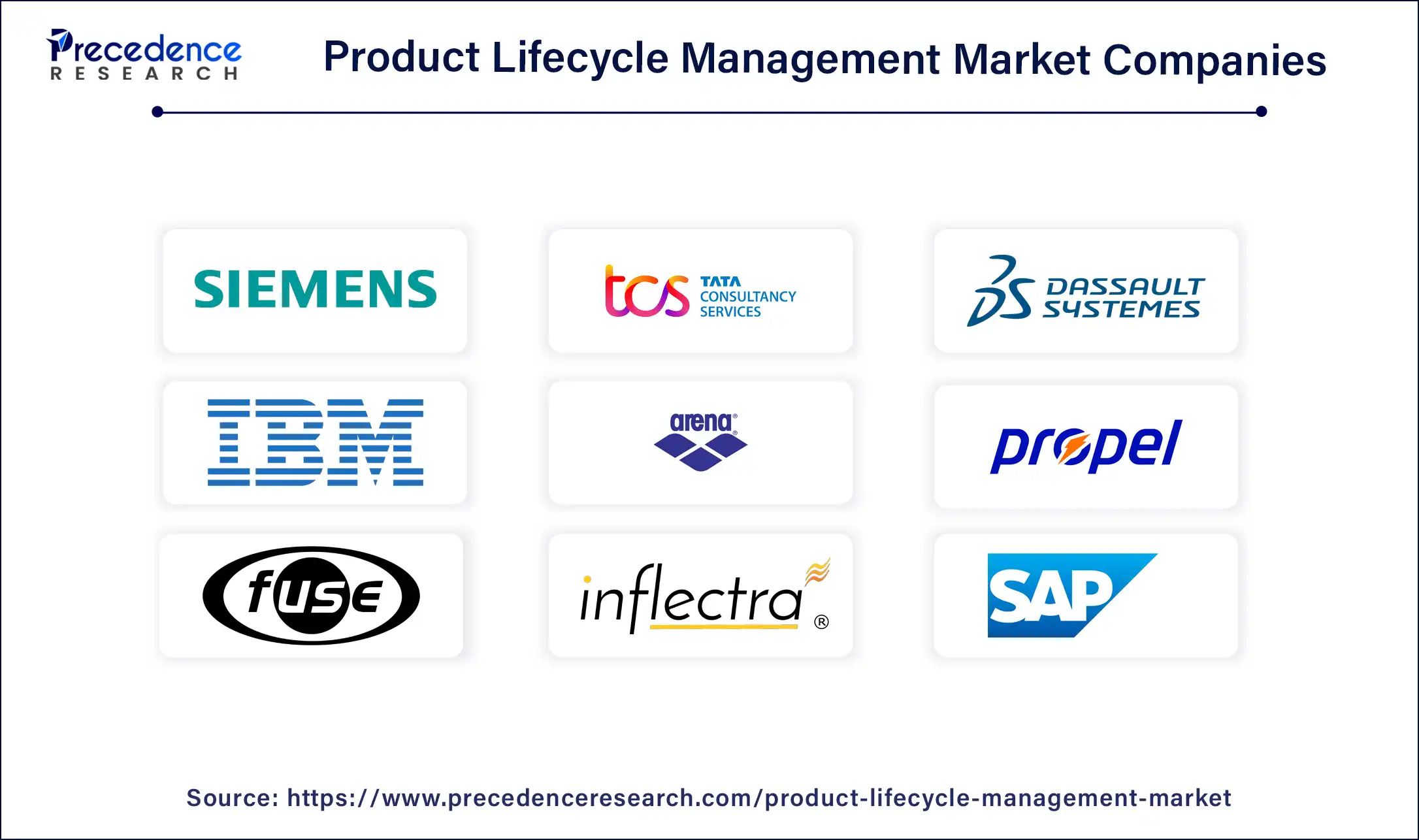List of Contents
What is Product Lifecycle Management Market Size?
The global product lifecycle management market size is estimated at USD 36.57 billion in 2025 and is anticipated to reach around USD 87.47 billion by 2035, expanding at a CAGR of 9.11% from 2026 to 2035.

Market Highlights
- North America dominated the global market with the largest market share of 36% in 2025.
- Asia pacific is projected to expand at the fastest CAGR during the forecast period.
- By software, the design and engineering segment contributed the highest market share of 32% in 2025.
- By software, The simulation, testing, and change management segment is predicted to grow with CAGR of 10.1% during the forecast period
- By deployment, the cloud segment captured the biggest market share of 71% in 2025.
- By deployment, The on-premise segment is expected the grow at a CAGR of 7.6% during the forecast period.
- By End Use, the automotive and transportation segment has held the largest market share of 23% in 2025.
- By End Use, the aerospace and defense segment is expected to grow at a remarkable CAGR during the forecast period.
Market Overview
Product lifecycle management refers to the processes of managing a product which goes through several stages including product introduction, product growth, maturity, and decline in the market. This management covers both the production and marketing of the products. The other essential activities like pricing, promotion through expansion, and cost-saving are managed by these solutions which assist in business decision-making. Product lifecycle management systems help businesses deal with tedious operational tasks and engineering issues of designing new products.
These systems are the strong supports for the information technology frameworks of any manufacturing corporation. They are essential for client communications, supplier relationships, and internal sources. At every stage of the product lifecycle, these PLM software enable organizations to make informed and data-driven decisions. The constantly changing parameters in the product lifecycle concerning time, performance, functionality, and price become crucial to meet the new requirements. These solutions also help to reduce costs and increase time efficiency in corporate innovations.
Role of Artificial Intelligence in the Product Lifecycle Management
The integration of artificial intelligence is essential for the automation and optimization of product lifecycle management processes. Artificial intelligence helps to enhance operational efficiency. It also suggests commands based on user behavior, history, and context by acting as an intuitive guide and training tool. AI also enables the auto-generation of problem reports and simulations which makes product management more efficient. Furthermore, AI-powered photorealistic visualizations can promote digital transformation and sustainability.
In May 2024, Siemens Digital Industries Software announced a strategic partnership with Microsoft to make Xcelerator as a service portfolio of industry software which is available through Microsoft's cloud and AI platform Azure to deliver AI-enhanced solutions for promising product lifecycle management with Azure.
Product Lifecycle Management Market Growth Factors
- The assurance of the product undergoing three phases the initial, middle, and final phases of the product lifecycle is driven by the product lifecycle management software and technology solutions.
- The PLM software solutions ensure the design and production at the initial phase while ensuring post-manufacturing activities in the middle.
- The other essential parameters including distribution, utilization, services phase, product recovery, recycling, etc. are assessed appropriately by using data-driven technology solutions.
- The increasing demand for cloud-based product lifecycle management solutions delivers scalability and secure information technology infrastructure and drives the growth of this market.
- The lower costs and more efficient production processes contribute to the increased adoption of product lifecycle management.
Market Scope
| Report Coverage | Details |
| Market Size in 2025 | USD 36.57 Billion |
| Market Size in 2026 | USD 39.94 Billion |
| Market Sizeby 2035 | USD 87.47 Billion |
| Growth Rate from 2026 to 2035 | CAGR of 9.11% |
| Base Year | 2025 |
| Largest Market | North America |
| Fastest Growing Market | Asia Pacific |
| Forecast Period | 2026 to 2035 |
| Segments Covered | Software, Deployment, End User, Region |
| Regions Covered | North America, Europe, Asia-Pacific, Latin America, and Middle East & Africa |
Market Dynamics
Drivers
A cloud-based deployment offers scalability and flexibility for modern businesses. It offers access to important product lifecycle management functions from any location which reduces the need for extensive IT infrastructure. The comprehensive and scalable PLM solutions facilitate supply chain collaboration, ensure regulatory compliance, and connect data with processes throughout the product lifecycle which creates a seamless digital connection. The organizations can monitor and manage the environmental impact of their products throughout the product lifecycle. These solutions are driving digital transformation and enhancing operational efficiency. Effective PLM depends on seamless integration with other enterprise systems. Siemens established a strong partnership network with leading industries like AWS, Microsoft, and NVIDIA to grow AI and cloud capabilities.
Restraint
The concerns related to data security, data integration, implementation costs, etc. are expected to challenge the market's growth over the forecast period. The complexity associated with PLM software and the lack of standardization processes challenge the market's growth. The engineering tools with various features, tools, and integration technologies make the software more complex. The complexity can lead to system difficulty, storage issues, costly errors, etc. There rises the need for high-end computers with ample storage and memory which makes them less portable and incompatible with low-power devices like laptops and tablets.
Opportunity
Small and medium-sized enterprises are increasingly adopting product lifecycle management solutions across various industrial sectors to optimize the manufacturing costs which drives the growth of the product lifecycle management market. Emerging technologies like additive manufacturing and engineering and augmented reality (AR) are expected to accelerate the market's growth remarkably. The integration of the Internet of Things (IoT) with PLM solutions will help in fulfilling digital transformation initiatives. IoT sensors in products and systems enable the creation of vast actionable data and insights.
- In August 2024, Siemens AG Supervisory Board announced executive leadership appointments to accelerate transformation and value creation.
Segment Insights
Software Insights
The design and engineering segment contributed the highest market share of 32% in 2024, Due to the technological advancements in design and engineering procedures. Continuous changes in these procedures led to the incorporation of new technology solutions driving the growth of this segment in the market. Business firms increasingly adopt compact and collaborative product development methodologies in product lifecycle management.
The simulation, testing, and change management segment is predicted to grow with CAGR of 10.1% during the forecast period due to the excellent applications of simulation and testing management software. This software assists companies in managing and controlling simulation processes, tools, data, and workflows as a part of a major product lifecycle management system.
Deployment Insights
The cloud segment captured the biggest market share of 71% in 2024,due to the outstanding advantages of cloud-based software in delivering flexibility, scalability, and data control. These benefits surge the demand for product lifecycle management software to deliver promising services to consumers or end users which drives the demand for the cloud segment in the market.
The on-premise segment is expected the grow at a CAGR of 7.6% during the forecast period due to the reliance of organizations on internet services and on-premise deployment. The on-premise deployment assists businesses in data storage and data security from internet fraud and major losses.
End User Insights
The automotive and transportation segment has held the largest market share of 23% in 2024due to the assistance of product lifecycle management software in the automotive and transportation sectors. The software enables companies and professionals to track automobile issues and respond to end-user issues which saves product dispatch time in the fields. These software help in transportation sectors in the reduction of shipment errors which results into less product damage and product defects. The software also enables on-time order delivery, improved business productivity, better alignment with customer expectations, and detailed regulatory compliance.
By end user, the aerospace and defense segment is anticipated to grow at the significant rate in the product lifecycle management market during the forecast period due to the increased competition in these fields. The other factors responsible to drive the demand for product lifecycle management solutions in aerospace and defense industries include low budgets and increasing commercial aircraft delivery long delays.
Service Insights
Managed Services Segment: Dominating
By service, the managed services segment dominated the product lifecycle management market in 2024 due to the incorporation of managed services in product lifecycle management to provide technology support and services for several product lifecycle stages. The assistance of managed service providers in product introduction enables product marketing, design, and simulation. These services also help in product growth which involves outsourcing, product activity, SEOs, etc. They also enable remote system monitoring, administration, testing, maintenance, etc. with the help of product lifecycle management software and the application managed services.
Support and Maintenance Services Segment: Fastest-Growing
By service, the support and maintenance services segment is expected to be the fastest growing in the product lifecycle management market over the forecast period due to their direct dealing with customer satisfaction and related issues. The presence of a dedicated support team with every software vendor delivers promising customer care. The beneficial services provided under the support and maintenance services include customer portal, support, software maintenance, client testimonials, and post-deployment assistance. The increased focus of service providers towards enhancing their product knowledge base by accepting feedbacks through interviews and surveys helps to deliver consistent customer satisfaction. The potential of these services in providing a single point of contact helps to solve customer issues immediately. The potential of customer portal to offer technical tips and software updates to customer forums also drives the growth of this segment in the market.
Organization Size Insights
By organization size, the large enterprises segment dominated the product lifecycle management market in 2024 due to the presence of large businesses with extensive product offerings. These large business firms get benefits by using advanced product lifecycle management solutions to streamline business processes, enhance strategic collaborations, and ensure regulatory compliance across their global operations. The increasing financial investments by these organizations in state-of-the-art product lifecycle management solutions drives innovation and maintains the competitive edge in the market.
By organization size, the small and medium-sized enterprises (SMEs) segment is anticipated to grow at the fastest rate in the product lifecycle management market over the forecast period due to the utilization of cloud-computing solutions in these organizational workflows. The advancements in technologies and the insertion of cloud-based software and related services drive the remarkable growth of this segment in the market.
Regional Insights
U.S. Product Lifecycle Management Market Size and Growth 2026 to 2035
The U.S. product lifecycle management market size is evaluated at USD 9.87 billion in 2025 and is predicted to be worth around USD 24.21 billion by 2035, rising at a CAGR of 9.39% from 2026 to 2035

North America dominated the product lifecycle management market with the largest market share of 36% in 2024. North America has always been at the forefront of adopting cutting-edge information technology and telecommunications technologies. Large corporations in North America are upgrading their product lifecycle management solutions to keep up with changing technology trends in order to support the development of new products. This region holds a strong financial position enabling it to invest increasingly in advanced technology solutions like the IoT, telecommunication (5G, LTE), and augmented reality (AR). The region also expands its capabilities by collaborating with connected industries, and additive manufacturing which offers a competitive edge in the market. Furthermore, large enterprises are growing and upgrading in their product lifecycle management solutions in line. The companies are also adopting evolving technology trends to deliver customer-centric product development. The launch of engineering lifecycle management solutions assists in industrial operations like scaling up engineering operations and managing tedious projects. These solutions utilize artificial intelligence to uncover real-time data insights across engineering.
Deloitte U.S. offers digital product lifecycle management transformation approach to enable clients in the assessment and implementation of their plans. These DPLM solutions enable clients in defining the scope and their vision, assessing the current state capabilities of the organizations, etc.

Asia pacific is projected to expand at the fastest CAGR during the forecast period. Several large enterprises in Asia-Pacific, comprising multiple industries and industry verticals such as automotive, aerospace, defense, telecommunications, and electronics are focusing on transforming their respective engineering processes and product development functions, and are deploying product lifecycle management tools aggressively. This region is growing with increasing demands for product lifecycle management solutions and the growing adoption of digitalization and industrialization in developing nations such as India and China. The presence of large enterprises working across dynamic industries including electronics, automotive, and telecommunication is focusing on transforming their engineering and product development processes and functions. The industries are highly deploying product lifecycle management tools as a major part of their growth strategies.
HCLTech offers digital design and innovation services which provides a technology and a platform for consulting, helping businesses to select the right technology, etc. These offerings enable them to define the implementation roadmaps and estimate the return-on-investment from the projects.
Product Lifecycle Management Market Companies

- Siemens AG
- TCS
- Dassault Systems
- IBM Corporation
- Arena
- Propel
- FusePLM
- Inflectra
- SAP SE
- Autodesk Inc.
Latest Announcements by Leaders
- In August 2024, Roland Busch, President and CEO of Siemens AG reported about an important step to involve Veronika and Peter to the Managing Board Team with their recommendable experience in finance, strategy, and technology. He also said that the extension of Cedrik Neike, the CEO of Digital Industries and Member of the Managing Board of Siemens AG will allow the company to build strength in automation and industrial software along with scaling digital capabilities and offerings.
- In April 2024, Denis Kennelly, General Manager of IBM Storage said that the IBM Storage Assurance challenges the enterprise storage with a program that delivers client-centric services, computational storage with AI-powered data services, and software integration designed to address customer issues by motivating them to adopt future innovations from IBM.
Recent Developments
- In April 2024, IBM Corporation announced about its new storage capabilities that will give clients a choice and control in the data center to maximize performance. IBM Storage Assurance is a new IT lifecycle management option which offers access to IBM FlashSystem hardware and software innovations to protect the investments of clients from the first day of their investment.In April 2024, IBM Corporation announced to acquire HashiCorp Inc. that creates a comprehensive end-to-end hybrid cloud platform for $35 per share in cash, highlightening an enterprise value of $6.4 billion.
Segments Covered in the Report
By Software
- Portfolio Management
- Design & Engineering Management
- Quality & Compliance Management
- Simulation, Testing & Change Management
- Manufacturing Operations Management
- Others
By Deployment
- On-premise
- Cloud
By End Use
- Aerospace & Defense
- Automotive & Transportation
- Healthcare
- IT & Telecom
- Industrial Equipment & Heavy Machinery
- Retail
- Semiconductor & Electronics
- Others
By Service
- Professional Services
- Deployment and Integration
- Consulting
- Support and Maintenance
- Managed Services
By Organization size
- Small and Medium-sized Enterprises (SMEs)
- Large enterprises
By Region
- North America
- Europe
- Asia Pacific
- Latin America
- Middle East and Africa
For inquiries regarding discounts, bulk purchases, or customization requests, please contact us at sales@precedenceresearch.com
Frequently Asked Questions
Ask For Sample
No cookie-cutter, only authentic analysis – take the 1st step to become a Precedence Research client



